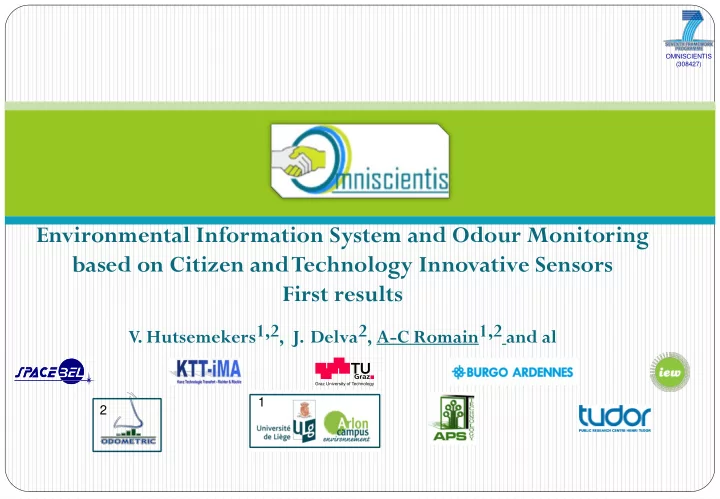

OMNISCIENTIS (308427) Environmental Information System and Odour Monitoring based on Citizen and Technology Innovative Sensors First results . Hutsemekers1,2, J. Delva2, A-C Romain1,2 and al V 1 2
Consortium OMNISCIENTIS (308427) Partner Country Contact OMNISCIENTIS (308427) SPACEBEL S.A Belgium Ph. Ledent Coordinator Research center University of Belgium AC Romain Liège University Odometric sa Belgium J. Delva Spin off APS technolgy Belgium B. Stevenot scrl Society TECHNISCHE Austria U. Uhrner UNIVERSITAE University T GRAZ KTT-IMA- France W . Kunz SARL society Henry Tudor Luxembourg Ph. Valoggia C Recherches Public + industrials, NGO, administration
OMNISCIENTIS (308427) Scope OMNISCIENTIS (308427) SCOPE of the OMNISCIENTIS project (FP7, start in October 2012) Mitigate the odour annoyance considering the stakeholders: the source of nuisance, the citizens living in the neighbourhood, the authorities at various levels Develop an Odour Environmental Monitoring Information System CHALLENGE integration of citizens as “ community-based ” observation providers giving the odour perception and discomfort in real time getting the feed-back in real time from a learning monitoring system
OMNISCIENTIS (308427) Odour Monitoring Information System (ODOMIS) OMNISCIENTIS (308427) web-based platform: the heart of the Information and monitoring system
OMNISCIENTIS (308427) Platform: Interaction scenario OMNISCIENTIS (308427) client-enoses-dispersion model — Partner: Spacebel WPS: Web Processing Service
OMNISCIENTIS (308427) Pilot Cases OMNISCIENTIS (308427) Pulp Paper mill in Belgium Pig farm in Austria
OMNISCIENTIS (308427) Odour Inputs for the dispersion model OMNISCIENTIS (308427) Odour emission data Partners: ULg-Odometric to estimate the Global Odour Rate versus time (fluctuations), continuously with Pulp paper mill Sources Odour rate • Real time process data (valve openings, flow rate, …) (ou E /s) • Odour flow rate measurements in the stacks Modo 48 423 Kvaerner 301 648 (ou E /s) Torch ? • E-noses in the proximity of area sources, in the Roof exhausts ambient air or in the stacks -surconcentration 346 10 6 • Chemical sensors (ie. electrochemical) and TRS 98 10 6 -siphon 1,1 10 9 -stripping analyser (for the paper mill only-UV fluorescence) Waste treatment a 803 337 1,4 10 6 Waste treatment b 7 246 + Meteorological data
OMNISCIENTIS (308427) Odour Inputs for the dispersion model OMNISCIENTIS (308427) Odour immission data Partners: ULg-Odometric-Tudor Date Distance (km) to validate (improve) the dispersion model by 4/04/2013 4 30/04/2013 3 • Experts: field inspection (CEN/TC 264/WG 27) 7/06/2013 4 • 32 watchmen (trained citizens, measurements 12/06/2013 13 twice a day, 4 days a week) 26/06/2013 7 11/07/2013 10 • Untrained Citizens 12/9/2013a 16 12/9/2013b 46 With Geomobile application 12/9/2013c 23 Partner: Spacebel 12/9/2013d 40 ODOMAP
OMNISCIENTIS (308427) Options OMNISCIENTIS (308427) Legend & Help Chrono Details Layers Automatic geolocation: GPS, WiFi or network, best option available.User can also locate himself manually
OMNISCIENTIS (308427) Odour prediction: the dispersion model OMNISCIENTIS (308427) Instant Odour Plume Maps Partners: TUG-KTT-iMA need to represent fast the peaks with new specific odour dispersion model Dispersion model “GRAL - System” Lagrangian dispersion model modified to be applied for odour
OMNISCIENTIS (308427) A living lab Approach OMNISCIENTIS (308427) Not only technically driven solutions but also socio-scientific approaches Partners: Ulg-Odometric-Tudor A progressive approach
OMNISCIENTIS (308427) Expected benefits OMNISCIENTIS (308427) For the stakeholders o Get the citizens in the loop : “give a voice to neighbours ” o Help industries in tuning nuisance generating processes- objectivation o Generate uncontroversial data and support local Authorities in decision ‐ making o Improve odour data input for legislative framework o Improve citizens well ‐ being
OMNISCIENTIS (308427) Conclusion and perspectives OMNISCIENTIS (308427) Current state after one year Platform is running Geomobile Apps is operational on smartphone (also web), used by the watchmen, citizens and experts Input odour data are collecting (e- noses; real time process data;…) E-noses data, ODOMap data, process data are in the WPS, sending info in real time to the platform Living lab is ongoing Next steps Integrate the input odour data to obtain the instantaneous global odour rate Finalize the odour adapted GRAL dispersion model and implement it in the WPS Connect the meteorological data, the input odour data, the stakeholders data to the dispersion model Validate the tool “ODOMIS”
OMNISCIENTIS (308427) OMNISCIENTIS Thanks for your attention (308427) A-C ROMAIN acromain@ulg.ac.be Environmental monitoring group Polluted atmospheres Department of environmental sciences Faculty of Sciences, ULg Arlon (Belgium) www. campusarlon . ulg .ac.be/ Project Coordinator: SPACEBEL Mr Philippe LEDENT, Angleur – Belgium philippe.ledent@spacebel.be +32 ‐ 4 361 81 11
Recommend
More recommend